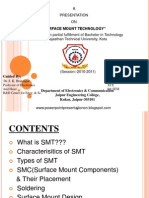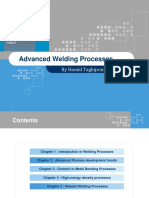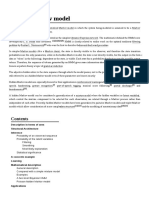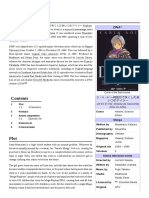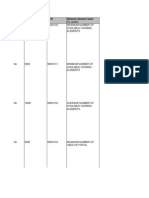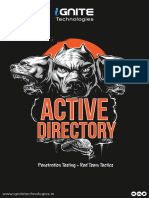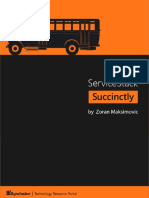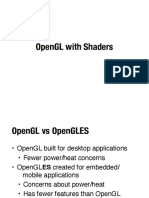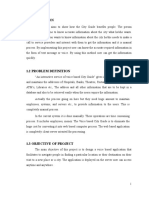Wave Soldering
Wave Soldering
Uploaded by
AjayChandrakarCopyright:
Available Formats
Wave Soldering
Wave Soldering
Uploaded by
AjayChandrakarCopyright
Available Formats
Share this document
Did you find this document useful?
Is this content inappropriate?
Copyright:
Available Formats
Wave Soldering
Wave Soldering
Uploaded by
AjayChandrakarCopyright:
Available Formats
Wave soldering
technology prevails (certain major appliances).
1 Wave solder process
A simple wave soldering machine.
There are many types of wave solder machines; however,
the basic components and principles of these machines
are the same. The basic equipment used during the process is a conveyor that moves the PCB through the dierent zones, a pan of solder used in the soldering process,
a pump that produces the actual wave, the sprayer for the
ux and the preheating pad. The solder is usually a mixture of metals. A typical solder has the chemical makeup
of 50% tin, 49.5% lead, and 0.5% antimony.[1]
Selective soldering machine
Wave soldering is a bulk soldering process used in the
manufacture of printed circuit boards. The circuit board
is passed over a pan of molten solder in which a pump
produces an upwelling of solder that looks like a standing
wave. As the circuit board makes contact with this wave,
the components become soldered to the board. Wave soldering is used for both through-hole printed circuit assemblies, and surface mount. In the latter case, the components are glued onto the surface of a printed circuit
board (PCB) by placement equipment, before being run
through the molten solder wave.
2 Fluxing
Flux in the wave soldering process has a primary and a
secondary objective. The primary objective is to clean
the components that are to be soldered, principally any
oxide layers that may have formed.[2] There are two types
of ux, corrosive and noncorrosive. Noncorrosive ux
requires precleaning and is used when low acidity is required. Corrosive ux is quick and requires little precleaning, but has a higher acidity.[3]
As through-hole components have been largely replaced
by surface mount components, wave soldering has been
supplanted by reow soldering methods in many largescale electronics applications. However, there is still 3 Preheating
signicant wave soldering where surface-mount technology (SMT) is not suitable (e.g., large power devices and Preheating helps to accelerate the soldering process and
high pin count connectors), or where simple through-hole to prevent thermal shock.[4]
1
11 FURTHER READING
Cleaning
through the process and can measure the temperature prole,along with contact times,wave parallelism and wave
Some types of ux, called no-clean uxes, do not re- heights. These xture combined with analysis software
quire cleaning; their residues are benign after the sol- allows the production engineer to establish and then condering process.[5] Typically no-clean uxes are especially trol the wave solder process.
sensitive to process conditions, which may make them
undesirable in some applications.[5] Other kinds of ux,
however, require a cleaning stage, in which the PCB is 9 See also
washed with solvents and/or deionized water to remove
ux residue.
Dip soldering
Thermal proling
Finish and quality
Quality depends on proper temperatures when heating
and on properly treated surfaces.
Solder types
Dierent combinations of tin, lead and other metals are
used to create solder. The combinations used depend on
the desired properties. The most popular combination is
63% tin, 37% lead. This combination is strong, has a
low melting range, and melts and sets quickly. Higher
tin compositions gives the solder higher corrosion resistances, but raises the melting point. Another common
composition is 11% tin, 37% lead, 42% bismuth, and
10% cadmium. This combination has a low melting point
and is useful for soldering components that are sensitive
to heat.[6]
Eects of cooling rate
It is important that the PCBs be allowed to cool at a reasonable rate. If they are cooled too fast, then the PCB can
become warped and the solder can be compromised. On
the other hand, if the PCB is allowed to cool too slowly,
then the PCB can become brittle and some components
may be damaged by heat. The PCB should be cooled
by either a ne water spray or air cooled to decrease the
amount of damage to the board.[7]
Thermal proling
Thermal proling is the act of measuring several points
on a circuit board to determine the thermal excursion it
takes through the soldering process. In the electronics
manufacturing industry, SPC (Statistical Process Control) helps determine if the process is in control, measured against the reow parameters dened by the soldering technologies and component requirements.[8] Products like the Solderstar WaveShuttle and the Optiminer
have been developed special xtures which are passed
Solder mask
10 References
[1] Robert H. Todd, Dell K. Allen, Leo Alting (1994).
Manufacturing Processes Reference Guide. p. 393.
[2] http://www.ipctraining.org/dvd/47c/script.pdf
[3] Todd p. 396
[4] Michael Pecht (1993). Soldering Processes and Equipment. p. 56.
[5] Giles Humpston, David M. Jacobson (2004). Principles
of Soldering. p. 118.
[6] Todd p. 395
[7] Todd, Robert H.; Allen, Dell K.(1994). Manufacturing
Processes Reference Guide. New York: Industrial Press
Inc.
[8] http://www.ipc.org/TOC/IPC-7530.pdf
11 Further reading
Seeling, Karl (1995). A study of lead-free alloys.
AIM, 1, Retrieved April 18, 2008, from http:
//www.aimsolder.com/techarticles/A%20Study%
20of%20Lead-Free%20Solder%20Alloys.pdf
Biocca, Peter (2005, April 5). Lead-free wave
soldering. Retrieved April 18, 2008, from EMSnow Web site: http://www.emsnow.com/npps/
story.cfm?ID=10669
12
12.1
Text and image sources, contributors, and licenses
Text
Wave soldering Source: https://en.wikipedia.org/wiki/Wave_soldering?oldid=694313094 Contributors: Michael Hardy, Julesd, Finlay
McWalter, Altenmann, Cholling, Giftlite, BenFrantzDale, Sam Hocevar, Vsmith, Smalljim, Share Bear, Hooperbloob, Visviva, Jet57,
Bushytails, Woohookitty, Christopher Thomas, RxS, Rjwilmsi, Borborygmus, Mgroat, Shaddack, GeeJo, Sylve, ScottWinder~enwiki,
SmackBot, Bluebot, Absentmindedprof, Dual Freq, Robosh, Atakdoug, Wizard191, Iridescent, MottyGlix, CmdrObot, Cydebot, Peripitus, Viscious81, BetacommandBot, Electron9, Jauricchio, MrMarmite, Jahoe, Edurant, Nar Rauko, Chapmanc, Andy.gock, Jirisundstrum,
VolkovBot, Volsfan, Davin, Funeral, Gdzuber, Flyer22 Reborn, Radon210, Assbackward, PixelBot, XLinkBot, Addbot, Ravenlord888,
Harry1717, Yobot, Fraggle81, Zithan, Felyza, Smart1234, A01102381, Dallascowboys618, Pedro ximenez, Pinethicket, Patyrc52, Humanoc, Example111, John of Reading, Racerx11, ZroBot, Dennish2, H3llBot, ClueBot NG, Captconan, Jeremy112233, Blahmoomoo,
Elizabethnorton, Professor1776 and Anonymous: 105
12.2
Images
File:Ecoselect_2_E_E.JPG Source: https://upload.wikimedia.org/wikipedia/commons/f/f2/Ecoselect_2_E_E.JPG License: CC BY-SA
3.0 Contributors: Own work Original artist: Pedro ximenez
File:Solder_wave.ogg Source: https://upload.wikimedia.org/wikipedia/commons/b/b7/Solder_wave.ogg License: CC BY-SA 3.0 Contributors: No machine-readable source provided. Own work assumed (based on copyright claims). Original artist: No machine-readable
author provided. Pedro ximenez assumed (based on copyright claims).
File:Wavesolderingmachine.jpg Source: https://upload.wikimedia.org/wikipedia/en/4/46/Wavesolderingmachine.jpg License: Cc-bysa-3.0 Contributors: ? Original artist: ?
12.3
Content license
Creative Commons Attribution-Share Alike 3.0
You might also like
- Surface-Mount Technology: HistoryDocument11 pagesSurface-Mount Technology: Historyulf8014100% (2)
- What You Always Wanted To Know About Wave Soldering But Were Afraid To AskDocument43 pagesWhat You Always Wanted To Know About Wave Soldering But Were Afraid To Asksmtdrkd100% (4)
- Minesight® Interactive Planner (Msip) Setup and CapabilitiesDocument22 pagesMinesight® Interactive Planner (Msip) Setup and CapabilitiesRCBNo ratings yet
- Wave Soldering: Wave Soldering Is A Bulk Soldering Process Used in TheDocument5 pagesWave Soldering: Wave Soldering Is A Bulk Soldering Process Used in TheMadhusudanan Ashok0% (1)
- Wave Soldering, KT20, 1000W, RHDocument7 pagesWave Soldering, KT20, 1000W, RHSuman TariqNo ratings yet
- Ap02014 R1 SolderingDocument7 pagesAp02014 R1 SolderingBernz Apura FernandezNo ratings yet
- What Is Wave Soldering Temperature Profile A Comprehensive Guide To SolderingDocument13 pagesWhat Is Wave Soldering Temperature Profile A Comprehensive Guide To SolderingjackNo ratings yet
- Technical Note 1 Recommended Soldering TechniquesDocument8 pagesTechnical Note 1 Recommended Soldering TechniquesVíctor Manuel Hernández PNo ratings yet
- MemsDocument35 pagesMemssureshmalliga100% (1)
- PIHR Book PDFDocument163 pagesPIHR Book PDFRanjitha BNo ratings yet
- 020221313131surface-Mount Technology - WikipediaDocument11 pages020221313131surface-Mount Technology - WikipediatbbhooligansNo ratings yet
- Ec 20ec41t w12 TheoryDocument5 pagesEc 20ec41t w12 TheoryNAVEENNo ratings yet
- SSSSSMMMMRTTTTTDocument8 pagesSSSSSMMMMRTTTTTshashishashank949No ratings yet
- Copper BrazingDocument44 pagesCopper BrazingJose Pablo Navarro Zamora100% (1)
- Types of PCB and Wave SolderingDocument4 pagesTypes of PCB and Wave Solderingpuranamravinder100% (2)
- Tecnicas de SoldaduraDocument8 pagesTecnicas de SoldaduraVictor CastellanosNo ratings yet
- PCB Design Process and IssuesDocument32 pagesPCB Design Process and IssuesCAMANO YSRAELNo ratings yet
- On Surface Mount TechnologyDocument23 pagesOn Surface Mount Technology11090480No ratings yet
- Wave Soldering of High Complexity PWB's FINALDocument12 pagesWave Soldering of High Complexity PWB's FINALrajppdNo ratings yet
- Soldering and DesolderingDocument24 pagesSoldering and DesolderingMedley CharlesNo ratings yet
- Unit - III Basic Manufacturing Engineering Surface Mount Technology (SMT)Document5 pagesUnit - III Basic Manufacturing Engineering Surface Mount Technology (SMT)rooplalrana1636No ratings yet
- Seamless Superconducting RF CavitiesDocument4 pagesSeamless Superconducting RF CavitiesCarlos ArenasNo ratings yet
- ELECTRONICSDocument11 pagesELECTRONICSWnikyla Manggad BalanguiNo ratings yet
- Hot Air LevelingDocument26 pagesHot Air LevelingAndersonNo ratings yet
- Application Note: Manual Lead-Free Soldering of LedsDocument11 pagesApplication Note: Manual Lead-Free Soldering of LedsFabio1947No ratings yet
- Dec 2011568Document5 pagesDec 2011568Nabi Jan ChoohanNo ratings yet
- 封裝設備保修實務(一) - 吉麥琳 (1)Document11 pages封裝設備保修實務(一) - 吉麥琳 (1)Wnikyla Manggad BalanguiNo ratings yet
- TH Soldering DefectsDocument15 pagesTH Soldering Defectssuphansa aiemsuwanNo ratings yet
- MME 1061 Workshop PracticeDocument111 pagesMME 1061 Workshop Practicekaleem zargarNo ratings yet
- Welding WeldingDocument10 pagesWelding WeldingaakankshaNo ratings yet
- SMTDocument18 pagesSMTAkash SinhaNo ratings yet
- Causes of PCB Delamination and How To Repair ThemDocument13 pagesCauses of PCB Delamination and How To Repair ThemjackNo ratings yet
- Unit-4 Unconventional Manufacturing ProcessDocument18 pagesUnit-4 Unconventional Manufacturing Processbrijkishor201767% (3)
- Advanced Welding ProcessesDocument103 pagesAdvanced Welding ProcessesHTANo ratings yet
- Automotive Steel Design ManualDocument22 pagesAutomotive Steel Design ManualftmrlNo ratings yet
- Res Welding Section 1Document20 pagesRes Welding Section 1Darryl007No ratings yet
- Basic PCB ManufactureDocument17 pagesBasic PCB Manufacturebobwillis1No ratings yet
- Handbook of Precision Engineering Volume 5 Joining TechniquesDocument305 pagesHandbook of Precision Engineering Volume 5 Joining TechniquesEduardo100% (1)
- What Is Selective SolderDocument5 pagesWhat Is Selective SolderjackNo ratings yet
- Welding, Brazing & Soldering PDFDocument9 pagesWelding, Brazing & Soldering PDFSuryakant PrabhuNo ratings yet
- Caps Mechanical Cracking in SMDs An0005Document8 pagesCaps Mechanical Cracking in SMDs An0005Lulu Sweet ThingNo ratings yet
- Effect of Solder Flux Residues On Corrosion of ElectronicsDocument7 pagesEffect of Solder Flux Residues On Corrosion of ElectronicsPaavo HeiskanenNo ratings yet
- Semiconductor Microchips And: Fabrication: A Practical Guide To Theory and Manufacturing Yaguang LianDocument64 pagesSemiconductor Microchips And: Fabrication: A Practical Guide To Theory and Manufacturing Yaguang LianobwpatmanNo ratings yet
- Introduction To Surface Mount Technology 24 April 2002 Helen HolderDocument38 pagesIntroduction To Surface Mount Technology 24 April 2002 Helen HolderbercincNo ratings yet
- Wave SolderingDocument13 pagesWave Solderingle truongNo ratings yet
- Basic Guideline of Soldering For Beginners CompressedDocument16 pagesBasic Guideline of Soldering For Beginners CompressedDamian Alejandro SalinasNo ratings yet
- Material Design Processing Communications - 2022 - Chadha - A Survey of Machine Learning in Friction Stir WeldingDocument28 pagesMaterial Design Processing Communications - 2022 - Chadha - A Survey of Machine Learning in Friction Stir Weldingchandramohan ENo ratings yet
- Detection & Prevention of Solder Joint Failure - Rush PCBDocument4 pagesDetection & Prevention of Solder Joint Failure - Rush PCBpeterpetermonNo ratings yet
- MECH 6541 - Quiz 2 - 40270483Document18 pagesMECH 6541 - Quiz 2 - 40270483abhiNo ratings yet
- DV03PUB124 Study Guide PDFDocument5 pagesDV03PUB124 Study Guide PDFraja020No ratings yet
- Practical Considerations For Attaching Surface-Mount ComponentsDocument7 pagesPractical Considerations For Attaching Surface-Mount ComponentsNilesh NarkhedeNo ratings yet
- Formulation of A New Liquid Flux For High Temperature SolderingDocument8 pagesFormulation of A New Liquid Flux For High Temperature Solderingdlucas62477No ratings yet
- Untitled DocumentDocument11 pagesUntitled DocumentCamilleNo ratings yet
- Printed Circuit Board Assembly Process: - The Comprehensive Guide!Document17 pagesPrinted Circuit Board Assembly Process: - The Comprehensive Guide!Shobanraj LetchumananNo ratings yet
- MechatronicsDocument13 pagesMechatronicsAnil KumarNo ratings yet
- Index: SR - NO. Topics NODocument21 pagesIndex: SR - NO. Topics NOSharath SuriNo ratings yet
- Engineering Workshop Notes Viva Questions PDFDocument12 pagesEngineering Workshop Notes Viva Questions PDFMbogi TokaNo ratings yet
- Automated Optical Inspection: Advancements in Computer Vision TechnologyFrom EverandAutomated Optical Inspection: Advancements in Computer Vision TechnologyNo ratings yet
- Welding Terminology: A Guide to MIG, TIG, Stick, Gas, and Spot Welding TermsFrom EverandWelding Terminology: A Guide to MIG, TIG, Stick, Gas, and Spot Welding TermsNo ratings yet
- Durg DistrictDocument2 pagesDurg DistrictAjayChandrakarNo ratings yet
- Ee) Is A Knowledge Base Website On Which Users: (Listen)Document13 pagesEe) Is A Knowledge Base Website On Which Users: (Listen)AjayChandrakarNo ratings yet
- Single CellingDocument1 pageSingle CellingAjayChandrakarNo ratings yet
- Clade: Clade: Clade: Clade:: Rosa RubiginosaDocument9 pagesClade: Clade: Clade: Clade:: Rosa RubiginosaAjayChandrakarNo ratings yet
- VHDL Made EasyDocument424 pagesVHDL Made EasyAjayChandrakarNo ratings yet
- Prison CellDocument2 pagesPrison CellAjayChandrakarNo ratings yet
- Hidden Markov ModelDocument17 pagesHidden Markov ModelAjayChandrakarNo ratings yet
- Unsupervised LearningDocument3 pagesUnsupervised LearningAjayChandrakarNo ratings yet
- Pattern RecognitionDocument9 pagesPattern RecognitionAjayChandrakarNo ratings yet
- Human Rights Act 1998Document10 pagesHuman Rights Act 1998AjayChandrakarNo ratings yet
- Minimum Spanning TreeDocument11 pagesMinimum Spanning TreeAjayChandrakarNo ratings yet
- DNA (Japanese: D: 1 Plot 2 Release 3 Anime Adaptation 4 References 5 External LinksDocument7 pagesDNA (Japanese: D: 1 Plot 2 Release 3 Anime Adaptation 4 References 5 External LinksAjayChandrakarNo ratings yet
- RNA InterferenceDocument26 pagesRNA InterferenceAjayChandrakarNo ratings yet
- Case Western Reserve University PDFDocument20 pagesCase Western Reserve University PDFAjayChandrakarNo ratings yet
- Mentor GraphicsDocument4 pagesMentor GraphicsAjayChandrakarNo ratings yet
- From Wikipedia, The Free EncyclopediaDocument6 pagesFrom Wikipedia, The Free EncyclopediaAjayChandrakarNo ratings yet
- Superscalar ProcessorDocument4 pagesSuperscalar ProcessorAjayChandrakarNo ratings yet
- Japanese Martial ArtsDocument13 pagesJapanese Martial ArtsAjayChandrakarNo ratings yet
- Donald KnuthDocument11 pagesDonald KnuthAjayChandrakarNo ratings yet
- Voucher Wifi Zone Une Journee Up 104 04.09.21Document12 pagesVoucher Wifi Zone Une Journee Up 104 04.09.21kodjo ELOMNo ratings yet
- WN7 0Document304 pagesWN7 0Karen Martinez0% (1)
- B2C Commerce Developer Exam SEM RESPOSTASDocument22 pagesB2C Commerce Developer Exam SEM RESPOSTASGIOVANE GOMES SILVANo ratings yet
- ABAP Programming GuidelinesDocument10 pagesABAP Programming GuidelinesHenrique OrçatiNo ratings yet
- Active Directory Pentest Course 1705144142Document10 pagesActive Directory Pentest Course 1705144142mansiraval262No ratings yet
- So Sánh Premier Hb9210 Và Arkray HA-8160 ProfileDocument2 pagesSo Sánh Premier Hb9210 Và Arkray HA-8160 ProfileOo Kenx OoNo ratings yet
- ASP Net Service Stack SuccinctlyDocument124 pagesASP Net Service Stack SuccinctlyDanielMolinaGiraldoNo ratings yet
- Shibendu S. Roy: Dept. of Mechanical EngineeringDocument27 pagesShibendu S. Roy: Dept. of Mechanical Engineeringsaded05No ratings yet
- ManageEngine Opmanager Enterprise DatasheetDocument4 pagesManageEngine Opmanager Enterprise DatasheetNetrunner TecnologiaNo ratings yet
- Neil Cameron - ESP32 Formats and CommunicationDocument657 pagesNeil Cameron - ESP32 Formats and CommunicationSai Krishna K VNo ratings yet
- Exercise Repetition - AnswerDocument5 pagesExercise Repetition - AnswerNurul Ain AmirNo ratings yet
- PRESENTATION DWG-sheet 3 PDFDocument1 pagePRESENTATION DWG-sheet 3 PDFanon_44947867No ratings yet
- Admin Image Option Editor GoEngineerDocument23 pagesAdmin Image Option Editor GoEngineerMichael DoyleNo ratings yet
- 670 Series ANSI: Engineering ManualDocument114 pages670 Series ANSI: Engineering ManualRK KNo ratings yet
- Teamcenter9: Siemens PLM Software (RU)Document67 pagesTeamcenter9: Siemens PLM Software (RU)Viktor AstapenkoNo ratings yet
- devish all unitDocument42 pagesdevish all unitAmrutha v jNo ratings yet
- Application Development and Emerging TechnologiesDocument5 pagesApplication Development and Emerging TechnologiesMarneil Allen SanchezNo ratings yet
- OpenGL ShadersDocument53 pagesOpenGL ShadersWladimir CarrilloNo ratings yet
- Power Bi Introduction and VisualizationDocument16 pagesPower Bi Introduction and VisualizationSaadie EssieNo ratings yet
- Control System Error Codes Diagnostic MessageDocument53 pagesControl System Error Codes Diagnostic MessageCristiano OliveiraNo ratings yet
- Allen-Bradley BASIC Module User's Manual (Cat. No. 1771-DB) : Use This Update WithDocument6 pagesAllen-Bradley BASIC Module User's Manual (Cat. No. 1771-DB) : Use This Update WithJohanNo ratings yet
- City Guide CompleteDocument77 pagesCity Guide Completemaliha riaz100% (1)
- Courses 2023Document3 pagesCourses 2023KCI InfoNo ratings yet
- Visual Basic MCQDocument19 pagesVisual Basic MCQamit_coolbuddy20100% (1)
- Logcat 1728897533389Document189 pagesLogcat 1728897533389AdeSupriadiNo ratings yet
- Key Point of C#Document10 pagesKey Point of C#naveenNo ratings yet
- ESdat Tutorial 3 1 Analysing ChemistryDocument20 pagesESdat Tutorial 3 1 Analysing ChemistryImad AghilaNo ratings yet
- Arridae Infosec PVT LTDDocument13 pagesArridae Infosec PVT LTDshimelisNo ratings yet
- Leo ADocument2 pagesLeo AAiko Ramos - BalababaNo ratings yet

















